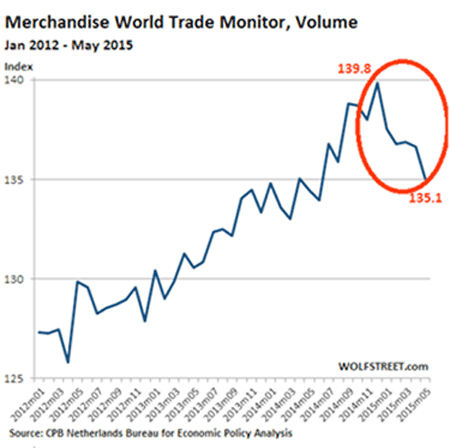Connecting the Dots: 6 Warning Signs That the Economy Is in Trouble
- Shannon Staton
- |
- August 4, 2015
- |
- Comments
On July 14, I wrote about the danger developing in the transportation sector, and things are looking even worse today. Here’s what I mean:
Look Out Below #1: Royal Dutch Shell reported its quarterly results last week—$3.4 billion, down from $5.1 billion for the same quarter a year ago—and warned that “today’s oil price downturn could last for several years.”
In anticipation of tough times, Shell slashed its 2015 capital expenditure budget by 20% and is going to lay off 6,500 high-paying jobs (not Burger King-type jobs) this year.
Look Out Below #2: UPS is a very good barometer of the consumer end of our economy: It’s the largest component of the Dow Jones Transportation Average both by sales and market valuation.
And UPS isn’t very confident about the US economy. Here is what UPS CEO David Abney said in a recent conference call with analysts:
If you just look at in [sic] January, the GDP forecast we thought was going to be about 3.1%. Now the thinking in July is about 2.3%, so let’s say a pretty significant decrease.
Why so glum?
The continued strength of the US dollar and I think this impending rate hike by the Fed appears to be holding back some US growth.
Abney has good reason to complain: UPS’s revenue fell 1.2% over the last 12 months. Not good.
Look Out Below #3: Rolls Royce may be best known for its luxury limousines, but the heart of its business is making engines for jet airplanes. Along with General Electric, the company dominates the aerospace engine business.
Business isn’t so good. Rolls Royce just issued its fourth profit warning in the last year and a half and is shutting down its $1.56 billion share buyback, introduced a year ago, to conserve cash.
The problem? Weak demand for its jet engines.
Hey, if Rolls Royce doesn’t want to buy its own stock… why should you?
Look Out Below #4: The reason Rolls Royce is suffering is that the airborne freight market is shrinking. While the passenger cabins you and I sit in may be full, the belly of the plane where the cargo freight is held is growing increasingly empty.
The International Air Transport Association (IATA) reported that air freight load factors have dropped to lows not seen since 2009.
“The expansion in volumes we saw in 2014 has ground to a halt, and load factors are falling… we have to recognize that business confidence is flat and export orders in decline,” said the CEO of IATA, Tony Tyler.
Look Out Below #5: The trans-ocean freight business isn’t doing any better; the number of idle container ships has increased two months in a row.
The number of idle ships (over 500 20-foot-equivalent units) has jumped from 82 to 108. Yup… business is so bad that the owners of 108 ships don’t have any business whatsoever.
“The traditional peak summer season has so far failed to provide a boost to vessel demand, as the weak cargo outlook is forcing carriers to cut back on their capacity deployment plans,” reported Alphaliner, a container shipping watchdog.
Look Out Below #6: The reason why all these transportation companies are struggling is that global trade is simply shrinking.
Moreover, world trade is falling at the fastest pace we’ve seen since the last financial crisis. Global trade shrank 1.2% in May from the previous month, and the little-followed World Trade index (which tracks import and export volume) fell to 135.1 in May.
Look, transportation companies prosper when the economy is rocking and rolling. However, they are among the first to feel a business slowdown when things turn downward.
My bashing of the transportation industry is just as much of a warning about the overall economy as transportation stocks. Do you have a contingency plan to protect your portfolio when things turn ugly?
The best time to prepare for trouble… is before trouble arrives. I recommend you take us up on our 90-day money-back guarantee and give my Rational Bear newsletter a risk-free try.

Tony Sagami
30-year market expert Tony Sagami leads the Yield Shark and Rational Bear advisories at Mauldin Economics. To learn more about Yield Shark and how it helps you maximize dividend income, click here. To learn more about Rational Bear and how you can use it to benefit from falling stocks and sectors, click here.






